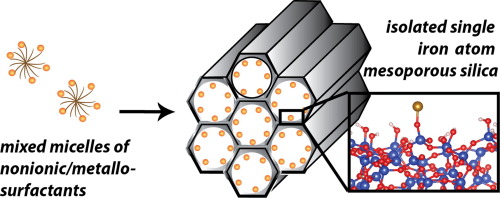当前位置:
X-MOL 学术
›
J. Colloid Interface Sci.
›
论文详情
Our official English website, www.x-mol.net, welcomes your
feedback! (Note: you will need to create a separate account there.)
Imprinting isolated single iron atoms onto mesoporous silica by templating with metallosurfactants.
Journal of Colloid and Interface Science ( IF 9.4 ) Pub Date : 2020-03-28 , DOI: 10.1016/j.jcis.2020.03.095 Y Berro 1 , S Gueddida 2 , Y Bouizi 3 , C Bellouard 4 , El-E Bendeif 5 , A Gansmuller 5 , A Celzard 6 , V Fierro 6 , D Ihiawakrim 7 , O Ersen 7 , M Kassir 8 , F El Haj Hassan 8 , S Lebegue 2 , M Badawi 2 , N Canilho 3 , A Pasc 3
Journal of Colloid and Interface Science ( IF 9.4 ) Pub Date : 2020-03-28 , DOI: 10.1016/j.jcis.2020.03.095 Y Berro 1 , S Gueddida 2 , Y Bouizi 3 , C Bellouard 4 , El-E Bendeif 5 , A Gansmuller 5 , A Celzard 6 , V Fierro 6 , D Ihiawakrim 7 , O Ersen 7 , M Kassir 8 , F El Haj Hassan 8 , S Lebegue 2 , M Badawi 2 , N Canilho 3 , A Pasc 3
Affiliation

|
HYPOTHESIS
One of the main drawbacks of metal-supported materials, traditionally prepared by the impregnation of metal salts onto pre-synthesized porous supports, is the formation of large and unevenly dispersed particles. Generally, the larger are the particles, the lower is the number of catalytic sites. Maximum atom exposure can be reached within single-atom materials, which appear therefore as the next generation of porous catalysts.
EXPERIMENTS
Herein, we designed single iron atom-supported silica materials through sol-gel hydrothermal treatment using mixtures of a non-ionic surfactant (Pluronic P123) and a metallosurfactant (cetyltrimethylammoniumtrichloromonobromoferrate, CTAF) as porogens. The ratio between the Pluronic P123 and the CTAF enables to control the silica structural and textural properties. More importantly, CTAF acts as an iron source, which amount could be simply tuned by varying the non-ionic/metallo surfactants molar ratio.
FINDINGS
The fine distribution of iron atoms onto the silica mesopores results from the iron distribution within the mixed micelles, which serve as templates for the polymerization of the silica matrix. Several characterization methods were used to determine the structural and textural properties of the silica material (XRD, N2 sorption isotherms and TEM) and the homogeneous distribution and lack of clustering of iron atoms in the resulting materials (elemental analysis, magnetic measurements, pair distribution function (PDF), MAS-NMR and TEM mapping). The oxidation and spin state of single-iron atoms determined from their magnetic properties were confirmed by DFT calculations. This strategy might find straightforward applications in preparing versatile single atom catalysts, with improved efficiency compared to nanosized ones.
中文翻译:

通过用金属表面活性剂模板将孤立的单个铁原子压印到中孔二氧化硅上。
假说传统上通过将金属盐浸渍到预先合成的多孔载体上而制备的金属载体材料的主要缺点之一是形成了大而分散的颗粒。通常,颗粒越大,催化部位的数量越少。在单个原子的材料中可以达到最大的原子暴露,因此它是下一代多孔催化剂。实验本文中,我们通过溶胶-凝胶水热处理设计了单铁原子负载的二氧化硅材料,使用非离子表面活性剂(Pluronic P123)和金属表面活性剂(鲸蜡基三甲基三氯一溴高铁酸盐,CTAF)的混合物作为成孔剂。Pluronic P123和CTAF之间的比例可以控制二氧化硅的结构和质地特性。更重要的是,CTAF充当铁源,可以通过改变非离子/金属表面活性剂的摩尔比来简单地调节其含量。发现铁原子在二氧化硅介孔上的精细分布是由于混合胶束中的铁分布引起的,这些胶束充当二氧化硅基质聚合的模板。几种表征方法被用于确定二氧化硅材料的结构和织构性质(XRD,N2吸附等温线和TEM)以及所得材料中铁原子的均匀分布和缺乏聚集(元素分析,磁测量,成对分布函数) (PDF),MAS-NMR和TEM图)。通过DFT计算证实了由单铁原子的磁性确定的氧化和自旋态。
更新日期:2020-03-28
中文翻译:

通过用金属表面活性剂模板将孤立的单个铁原子压印到中孔二氧化硅上。
假说传统上通过将金属盐浸渍到预先合成的多孔载体上而制备的金属载体材料的主要缺点之一是形成了大而分散的颗粒。通常,颗粒越大,催化部位的数量越少。在单个原子的材料中可以达到最大的原子暴露,因此它是下一代多孔催化剂。实验本文中,我们通过溶胶-凝胶水热处理设计了单铁原子负载的二氧化硅材料,使用非离子表面活性剂(Pluronic P123)和金属表面活性剂(鲸蜡基三甲基三氯一溴高铁酸盐,CTAF)的混合物作为成孔剂。Pluronic P123和CTAF之间的比例可以控制二氧化硅的结构和质地特性。更重要的是,CTAF充当铁源,可以通过改变非离子/金属表面活性剂的摩尔比来简单地调节其含量。发现铁原子在二氧化硅介孔上的精细分布是由于混合胶束中的铁分布引起的,这些胶束充当二氧化硅基质聚合的模板。几种表征方法被用于确定二氧化硅材料的结构和织构性质(XRD,N2吸附等温线和TEM)以及所得材料中铁原子的均匀分布和缺乏聚集(元素分析,磁测量,成对分布函数) (PDF),MAS-NMR和TEM图)。通过DFT计算证实了由单铁原子的磁性确定的氧化和自旋态。











































 京公网安备 11010802027423号
京公网安备 11010802027423号